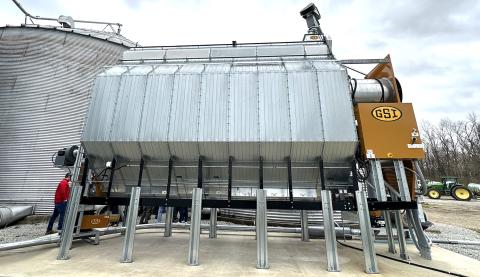RICHMOND, Va., June 27, 2024 – A Surry County cattle operation was included in yesterday’s U.S. Department of Agriculture (USDA) announcement of nearly $100 million in loans and grants awarded through the Rural Energy for America Program (REAP) to support 473 clean energy partnership projects in 39 states and Puerto Rico.
Huntington Farm is receiving a $72,654 grant to purchase and install an energy efficient grain dryer that will provide the optimal balance between heat level, retention time and air flow to support more economical production of quality grain supplements for pasture-raised Red Angus cattle. Crop and hay production help the fourth-generation operators provide a wide variety of nutritional feed sources for their grass-fed, grain-finished beef raised with no added hormones or antibiotics.
“The Biden-Harris Administration and USDA are committed to ensuring that farmers and small businesses directly benefit from both a clean energy economy and a strong U.S. supply chain,” said Perry Hickman, USDA Rural Development Virginia State Director. “These investments will cut energy costs for businesses and agricultural enterprises like Huntington Farm, increasing their resiliency and allowing them to invest back into their communities by creating new jobs and other opportunities.”

The REAP program helps agricultural producers and rural small business owners expand their use of wind, solar, geothermal and small hydropower energy and make energy efficiency improvements. Since the start of the Biden-Harris Administration, USDA has invested more than $2.1 billion through REAP in 7,216 renewable energy and energy efficiency improvement projects nationwide.
USDA is also making the REAP awards in Alaska, Alabama, Arkansas, Arizona, California, Colorado, Delaware, Georgia, Hawaii, Iowa, Idaho, Illinois, Indiana, Kansas, Kentucky, Louisiana, Maryland, Michigan, Missouri, Mississippi, Montana, North Carolina, North Dakota, New Hampshire, New Mexico, Nevada, New York, Ohio, Oklahoma, Pennsylvania, South Carolina, South Dakota, Tennessee, Texas, Utah, Vermont, Washington, West Virginia, Wyoming and Puerto Rico. A complete list can be found online.
USDA Secretary Tom Vilsack's announcement included more than $375 million in funding offered through REAP and the Powering Affordable Clean Energy Program (PACE). USDA also unveiled the “Rural Energy Resource Guide” to make it easier for rural communities to identify federal funding for clean energy, including programs made possible by President Biden’s historic Inflation Reduction Act that helped finance many of these projects.
PACE and REAP advance President Biden’s Investing in America agenda and are part of the Justice40 Initiative, which aims to ensure that disadvantaged communities marginalized by underinvestment and overburdened by pollution receive 40 percent of the overall benefits of certain federal climate, clean energy and other investment areas.
USDA continues to accept REAP applications and will hold funding competitions quarterly through Sept. 30, 2024. The funding includes a dedicated portion for underutilized renewable energy technologies. For additional information, contact Virginia Energy Coordinator Tracey Krespach at tracey.krespach@usda.gov or (804) 287-1606.
USDA Rural Development provides loans and grants to help expand economic opportunities, create jobs and improve the quality of life for millions of Americans in rural areas. This assistance supports infrastructure improvements; business development; housing; community facilities such as schools, public safety and health care; and high-speed internet access in rural, tribal and high-poverty areas.
Visit the Rural Data Gateway to learn how and where these investments are impacting rural America.
